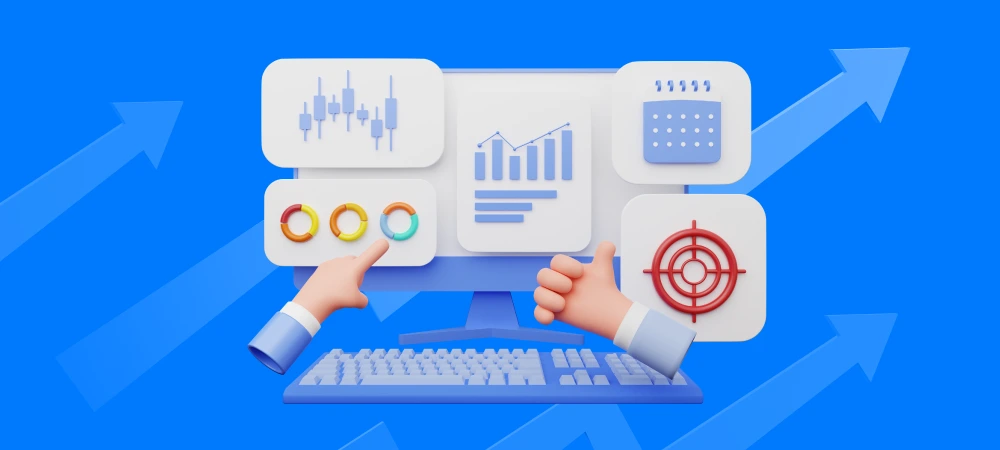Success, for most businesses, translates to growth. And not just any growth, only the fast yet sustainable kind. But when you meet a challenging sales target, such as “3X your revenue this quarter”, it sets decision makers and teams haywire.
Running around aimlessly without a plan isn’t the solution here. But you don’t need to be a fortune-teller to know your business’s future; sales forecasting is a predictive science that lays the groundwork for you.
It’s also where most businesses go wrong. Because unfortunately, forecasting sales isn’t as standardized or easy as it seems. There are quite a few challenges that can set off your estimates, and as a result, only 20% of organizations have a sales forecasting accuracy of 75% or greater (Source: Korn ferry).
This guide will help you improve the accuracy of your sales forecast, that’ll boost your sales revenue this quarter! Let’s get into the what, why, and how of sales forecasting.
What is Sales Forecasting?
Sales forecasting is the method of predicting how well your business will do—in terms of revenue or potential deals closed—based on your sales team’s performance. This estimate allows businesses to project the outcomes of their results and accounts for any gaps in budgeting or personnel adjustments.
Sales forecasts heavily depend on the type of business, your sales process, market conditions, and competition, among many other factors.
Why Do Businesses Invest in Sales Forecasting?
An unpredictable sales process results in your business’s completely random cash flow. The lack of the right forecast affects your company’s decisions toward growing faster. These include both short- and long-term decisions for multiple teams.
Short-term spending decisions
Without an accurate forecast, sales leaders may not have the right budget for sales enablement and hiring. For example, they might invest a lot in training and recruitment but might still close lesser deals because of the market conditions.
Long-term external and internal decisions
Publicly listed companies need an accurate forecast to present to their shareholders and investors. An inaccurate forecast affects the stock price and performance as well. The internal decisions for a company may include the launch of a new product or changes in the pricing model. In such cases, the sales forecast helps businesses predict the performance and the right opportunity to implement these plans.
Along with making significant decisions, sales forecasts also help you improve different sales-linked aspects of your business.
5 Benefits of Sales Forecasting
Fast-growing businesses that rely on error-free forecasts are twice as likely to lead in their field while being 10% more likely to grow revenue year-over-year. Here are the five benefits of sales forecasting that help them achieve this.
1. Improve Resource Allocation
If the forecast for the upcoming quarter looks promising, sales leaders can introduce new commission plans and even offer discounts to their customers to improve conversions while staying profitable. In an alternative scenario, if the predicted seasonal lead flow is low, these resources can be allocated to the marketing team to improve lead generation.
2. Decrease Pipeline Risks to Improve Conversions
Any sales process has different stages which might accelerate or decrease conversions. The top of your sales funnel may have 100 potential deals, resulting in 10 conversions that month. An accurate forecast considers this sales pipeline risk to either increase the top of funnel deals, fix the pipeline stage, or focus on leads with a higher intent to buy.
3. Reduce Inventory and Warehouse Costs
B2C businesses, such as agriculture and FMCG sector, use forecasts to decrease the budget for inventory management for products with a low shelf life. Sales forecasts help predict how much storage space or units would be needed for processing and manufacturing plants for a certain time frame.
4. Improve Recruitment
A quarter that has new product launches or when your business is expanding territories needs a bigger task force. Here’s when you amp up the hiring and training. But you can keep the hiring on hold for a quarter with a low predicted outcome to focus on the business process instead.
5. Motivate Sales Teams to Improve Performance
Salespeople love challenges, and forecasting helps you set the difficulty to keep them engaged. Using historical data and market projections ensures that the sales targets set are realistic and achievable for your team. You can also break them down to an individual level based on performance.
While sales forecasting isn’t rocket science, it can get complex owing to incomplete sales data and growing teams. How businesses project their growth differs in how they operate and manage their teams. Overall, there are a few approaches that businesses generally opt for.
Approaches to Sales Forecasting
The bottom-up, top-down, and qualitative approach is what businesses choose from to plan their revenue targets.
1. Top-Down Approach:
This approach is aspirational, where the leaders chart the growth plans. For example, an 80% increase in revenue or doubling the number of units sold by next year. The top-down approach takes the following factors into account:
- Market Scenario
- Industry growth
- Total addressable market (TAM)
- Global economy
- Competitor growth
- Stage that the company is in
It is an aggressive strategy to capture a greater market share and knock off the competition. At the same time, it can also be a bit unrealistic and rigid on your team if the forecast doesn’t consider all aspects.
2. Bottom-Up Approach:
As the name suggests, the bottom-up approach starts at the ground level by analyzing sales performance. It uses the historical sales data to plan the next quarter or fiscal year. Sales managers and team members are very involved in this decision. The following are a few metrics that are considered in the bottom-up approach:
- Number of members in each team
- Number of deals closed
- Number of potential deals
- Sales pipeline velocity
- Percentage of target met every quarter
- Industry or region-wise performance
- Lead quality
- Length of the sales cycle
Compared to the top-down approach, this forecast is more realistic and accurate. The leaders know their team’s potential and the resources needed to boost their performance. While this approach is data-driven, it can be a conservative approach for businesses in the early stages.
The top-down and bottom-down approaches are highly quantitative, and companies equipped to track accurate sales data prefer quantitative methods over qualitative methods. But in some cases, a few qualitative forecasting methods need to be implemented.
“While forecasting sales, a cookie-cutter template can’t work for every business. Successful businesses aim to balance the top-down and bottom-up approaches so that the outcomes of both the forecasts align at a common ground. It proves to be a great way to ensure that your sales targets help your business grow, at a realistic rate.”
Aiwin Joshy, Associate Director- Finance and Accounts, LeadSquared
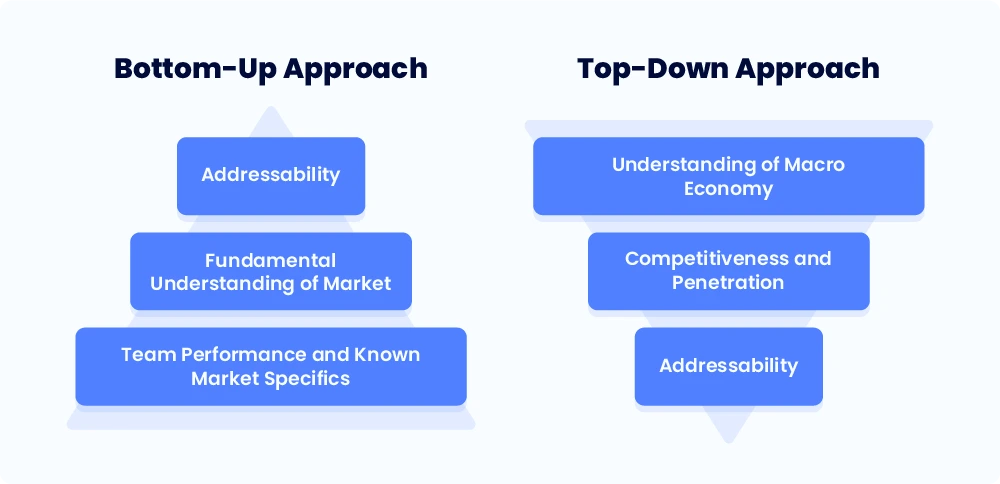
3. Qualitative Approach
Uncertainty in businesses isn’t uncommon; it’s something that every company faces at some point. Whether you’re launching a new product, creating a niche market segment, or opting for a non-traditional sales process, your historical data can’t help you validate your forecasts.
Businesses rely on consultants, internal experts, and managers in such situations for their targets. The qualitative forecast is highly intuitive, and businesses must conduct strong market research for an accurate outcome.
This approach also helps seasoned salespeople forecast how well their teams are achieving their goals. Along with validating the long-term plan, their experience helps them predict closures for critical and high-value deals. This is an essential skill because it helps ensure that the forecast is also being executed correctly.
“A good salesperson picks up on emotional cues to identify the leads that qualify as a “low hanging fruit.” Their interest in your product, the level of excitement, involvement of decision-makers, and a healthy budget-related discussion—are the positive signs you should look for. Instead of spending 90% of your time in nurturing leads, you can use these cues to identify opportunities with a higher chance of a conversion.”
Vineet Tiwari, Assistant Vice President-Sales, LeadSquared
By this point, you would’ve realized that forecast reports are quite a necessity for your sales team. Yet only 45% of sales leaders and sellers confidently believe in their organization’s forecasting accuracy. Salespeople spend over 2.5 hours weekly forecasting sales that might not yield concrete results.
“While a wealth of sales data and new analytics solutions promise to help, finding the signal in all the noise is often difficult and time-consuming. Customers simply don’t follow a linear progression of steps to arrive at a buying decision, which complicates the sales pipeline.”
Craig Riley, Senior Principal Analyst, Gartner’s Sales Practice.
There’s a threefold solution to this problem!
#1 Choose a sales forecasting method that works for your business
#2 Implement this model with the right sales tool and process
#3 Combat sales forecasting challenges by adopting practices
Let’s break down each step and dive into the details of this solution.
#1 Choosing A Sales Forecasting Method
The forecast can depend on the business context, competitor performance, and the quality of sales data available. Even if the forecast technique might be relevant to your business, it won’t be accurate unless you have a couple of years of data to validate it.
So instead of choosing an advanced technique to sales forecasting, you should opt for a method with existing data based on your product’s life-cycle stage. Here are five common sales forecasting methods that you can choose from:
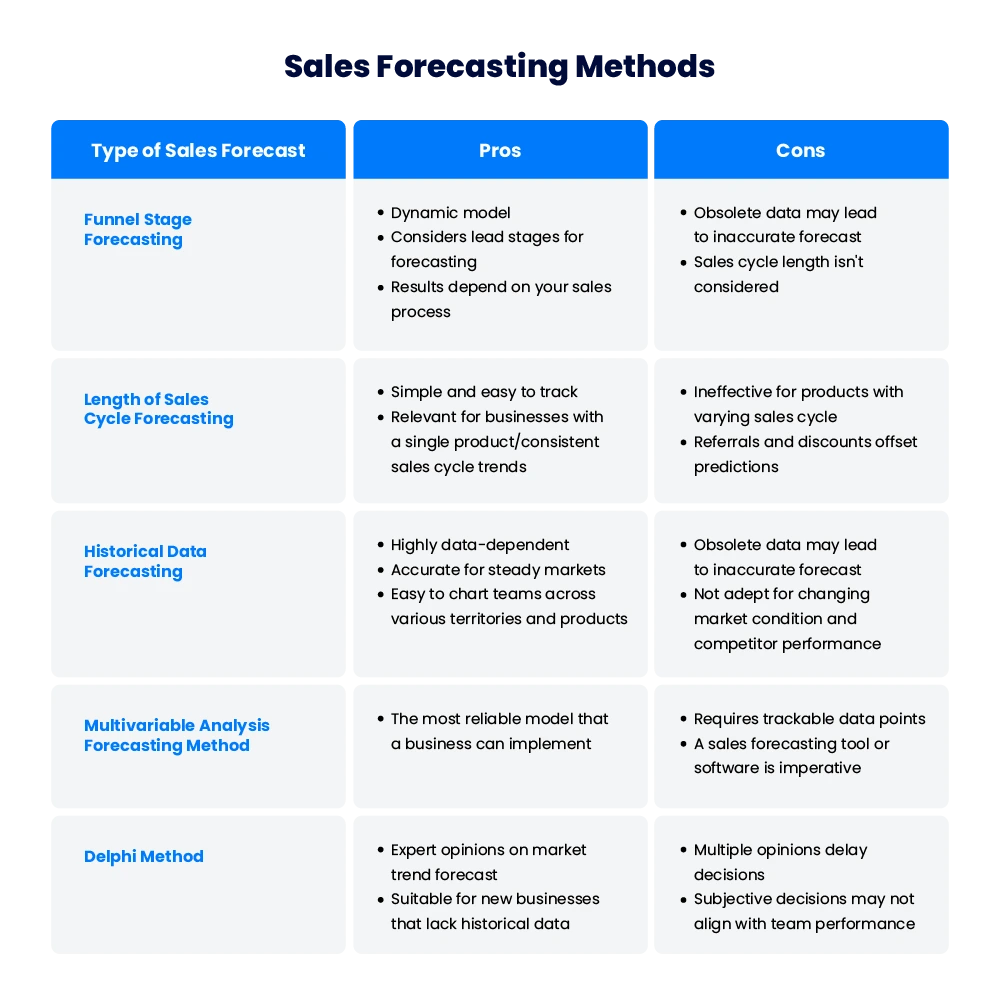
1. Funnel Stage Forecasting
The sales process has many stages that a lead goes through before the deal is closed. Lead funnel stage forecasting attributes a specific expected percentage of closure for each of these stages. This method helps you estimate the potential revenue your sales teams will generate based on your sales process.
Example: If your sales process stages and associated potential of closures looks like this:
| S.no. | Sales Stage | Closing Potential |
| 1. | Marketing Qualified Lead | 10% |
| 2. | First Positive Interaction | 15% |
| 3. | Demo Completed | 35% |
| 4. | Opted for Trial | 50% |
| 5. | Discussed Budget | 70% |
| 6. | Final Call | 80% |
| 7. | Deal Closed | 100% |
For a deal valued at $4000, the potential forecast value for a leader who has opted for a trial will be $4000 * 50% = $2000 (the deal value multiplied by the closure potential).
Pros:
- It is a dynamic model that considers each lead stage.
- The lead stage is the only metric that needs to be tracked and the forecast is closely linked to the sales process.
Cons:
- The sales data needs to be continually updated otherwise
,the forecast will be inaccurate. - It doesn’t account the length of the sales cycle, which means that a deal stuck at one stage for three months and a deal that takes two weeks to close will show the same potential.
2. Length of Sales Cycle Forecasting
Forecasting based on the length of the sales cycle only considers the total time that it takes to close a deal.
Example: If your sales cycle length is 40 days, at 20 days, you can predict that the deal has 50% potential to close.
Pros:
- This method is simple and easy to track for businesses with a single product or similar sales cycle trends.
Cons:
- Sales cycles differ in length based on the product and the market state. Keeping previous performance might set an unrealistic forecast.
- Referrals, discounts, and the introduction of new products can offset your predictions.
3. Historical Data Forecasting
A simple way to what you can achieve in the future is to look back at how well you have fared in the previous quarter, month, or year. The historical data accounts for sales performance metrics like deals closed, revenue achieved, and the number of targets met—from a completely bottom-up approach.
Example: If your business generated $5000 in November last year, your base target would be $5000 or more based on your projected growth rate. With a growth rate of 15%, your target for November this year will be $5750.
Pros:
- This forecast model is highly data-dependent, so the forecast will be accurate and easy to achieve when markets are steady.
- It is easy to chart teams across different territories and for various products.
Cons:
- All the data needs to be in place and accurately captured to create a forecast.
- A business cannot rely on this forecast if the market condition, competitor performance, or demand for the product changes over time.
4. Multivariable Analysis Forecasting Method
Sales performance management depends on multiple factors. Instead of a linear forecast, businesses rely on a multivariable analysis for relevant forecasts. The multivariable analysis takes it a step ahead by predicting the salesperson’s performance based on pre-recorded metrics.
This advanced analytics model considers deal size, individual performance, length of the sales cycle, win rates, and just about every metric.
Example: For a salesperson, if they have a reasonable win rate, with a deal value of $1000, the conversion potential can be 60% based on their performance. In this case, their contribution to the sales forecast will be $600.
Pros:
- The multivariable analysis forecasting method is the most reliable model that a business can implement.
Cons:
- Businesses need to ensure that salespeople enter all the data on a trackable platform. Without data, the predictions lack accuracy.
- A lot of tracking, reporting, and calculation are required for this model. A sales forecasting tool or software is imperative to carry out this forecasting.
5. Delphi Method
The Delphi method is one of the qualitative ways to forecast sales. Here a panel of experts answers a list of questions or cater to the problem statement the business faces. A decision for the forecast is made based on their responses.
Pros:
- Experts who understand the sales cycle and market trends forecast conversions for you.
- Works the best for new products or businesses that lack historical data to make decisions.
Cons:
- Multiple opinions mean that there might be discrepancies and no solution that the majority abide by.
- It is subjective to the decisions that the experts make and might not align with the performance of your sales teams.
A few more forecasting models may be relevant to other businesses, but the ones mentioned above are the easiest to implement and execute. Before you have a forecast ready to share with your teams, you must make sure that it complies with your sales process and other tools.
#2 Implement This Model With the Right Sales Tool and Process
Once you’ve chosen a sales forecasting model, you must ensure that your sales process has well-defined stages and optimal strategies.
Here’s a guide that’ll help you improve your sales process: 6 Sales Process Steps You Should Be Following
The only challenge here is that the forecasting system must collect the relevant data and sales metrics. There are a few sales tools that you can use for smoother forecasting. The most popular ones are:
1. Excel
The simplest tool any small organization can begin with to forecast revenue and closures. Using basic calculations, storing and processing your data on Excel sheets is possible. But as your organization scales up, Excel sheets lead to inaccuracies and mismanaged data with a higher chance of human error.
2. CRM
An end-to-end CRM software is the perfect tool to optimize revenue intelligence. Since all the data is automatically captured and distributed over the platform, a good CRM does the forecast for you. One-click reports and data-visualization tools make the LeadSquared CRM a perfect tool for sales forecasting.
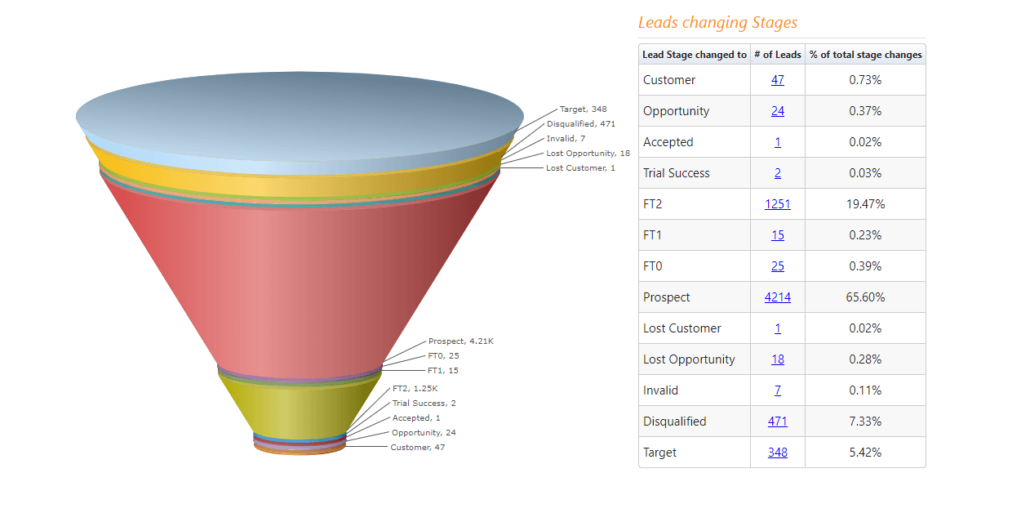
3. Sales Analytics platforms
Creating a relevant forecast for your business involves tracking relevant sales analytics and metrics that measure team performance and the current business scenario. Sales analytics tools help you collect this data and can be integrated with another tool to generate reports.
4. Project management tools
These tools help you analyze the budgeting and resource allocation your teams need to achieve their goals. Automated timesheets and the ability to track tasks across the project lifetime help managers plan the team’s targets effectively.
5. Lead scoring tools
Lead Scoring tools are an excellent option for businesses that use the funnel stage forecasting model. A closure percentage can be attributed to a lead score, or a range of lead scores, to build the forecast for potential deals. It also helps you personalize your sales and marketing approach.
6. Accounting tools
Businesses that set targets based on revenue can use their accounting software for a top-down approach to forecasting. It also integrates cost of lead data from multiple marketing and support/implementation teams to determine the actual deal size and net revenue.
Sales Forecasting Software Checklist
If you’re looking to revamp or adopt a new technique, both the forecasting model and tool need to be compatible. Here’s a checklist of the features that you should evaluate before you purchase a new sales forecasting software:
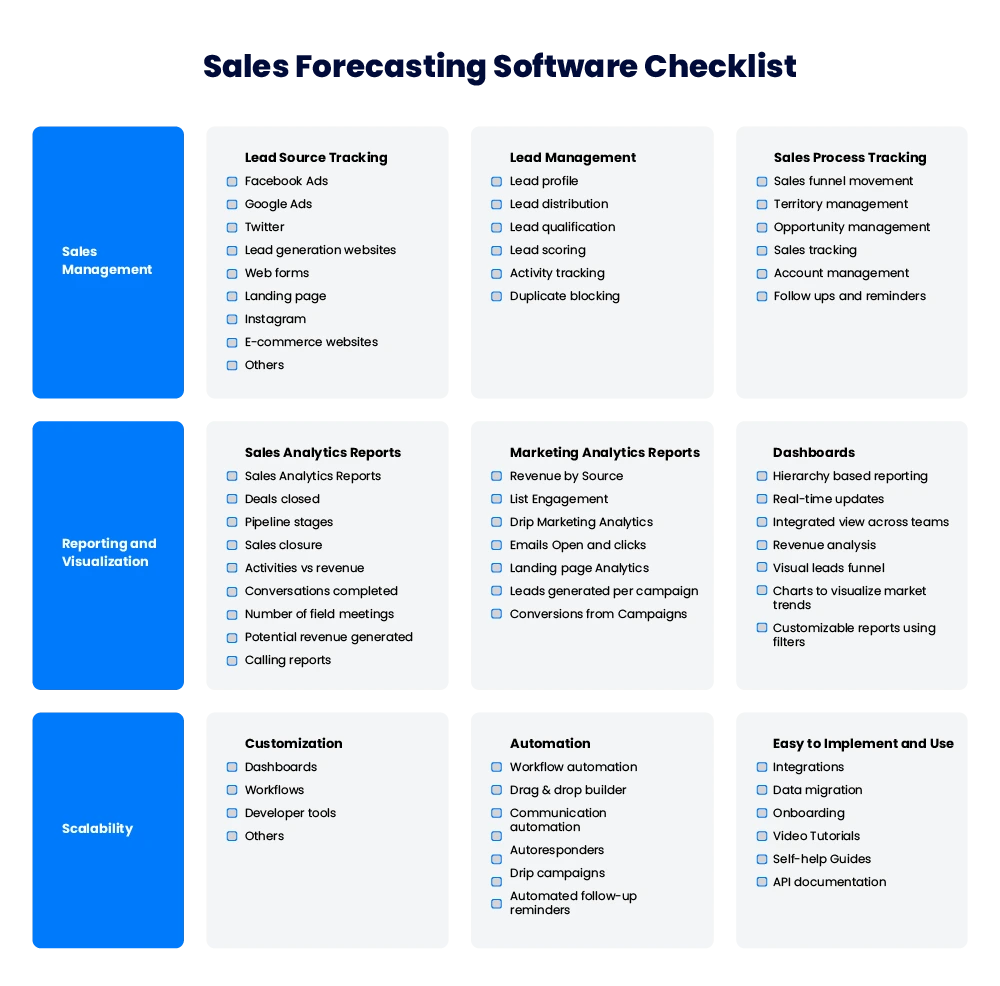
You can also download this checklist to share it with your team or refer to later: Sales Forecasting Software Checklist.
Any tool or solution that you choose for forecasting must enable your business to have:
1. Complete Visibility Across Teams and Processes A sales forecast needs information from each stage and multiple teams—marketing, finance, and sales—to predict revenue. So, the tool you choose must collect accurate data, store it, and make it accessible to the decision-makers.
2. Access to Customizable Reports Various hierarchies in your organization must be able to use the forecasting tool for weekly, monthly, and quarterly forecasts. For an accurate forecast, the tool should let you create reports using filters for various customer segments, product lines, and internal teams.
3. Ability to Implement Various Forecasting Techniques
With changing market trends or while introducing a new product, you might have to adopt a different forecasting strategy in the future. So, you need a flexible tool that can cater to your needs in terms of the workflows and data available.
4. Visualization Capabilities
The tool should visualize your sales data in every way possible–charts, tables, graphs, or tables. It’s important to note that the visualization must be real-time and easy to generate and access.
5. Scalable Forecasts for Growing Businesses
Can the tool handle the data when your team and the number of leads increase by 10X or 15X? If you aim to grow rapidly, your sales forecasts need to scale along with your business.
6. A Platform to Automate Sales Forecasting Processes
On average, salespeople spend hours in forecasting every week. This time goes into entering the data and creating reports. As a business, you can invest in a tool that automates these tasks and helps salespeople focus on just closing their deals.
Sales forecasting isn’t as daunting as it seems once you have a tool with all these features. Most businesses opt for a CRM to help them with error-free forecasting because it is an affordable and apt solution to forecasting challenges.
#3 Adopt Best Sales Forecasting Practices
With the metrics and reporting in place, there are just a few challenges that enterprises should be aware of. Here are the best practices that you can adopt to avoid any offsets in your forecasts:
1. Maintain CRM Hygiene
When quantitative data is the foundation for your forecasting framework, a lack of it can lead your business into trouble. Data that is partially registered creates many outliers that disrupt revenue intelligence. Salespeople must ensure that all the data related to their deals is accurately added to their CRM/ lead management platform.
2. Decrease Reliance on Subjectivity
“Optimism is a necessary trait in a good salesperson. However, that same optimism becomes a problem when it combines with qualitative inputs and intuition as the primary source of information for a forecasting spreadsheet.”
Tom Pisello, Chief evangelist, Mediafly
Seller subjectivity isn’t a reliable source of truth. While setting targets, leaders must strike a balance between the salesperson’s intuition and accurate data points.
3. Don’t Overestimate Sales Performance
Unattainable sales forecasts just demotivate your teams. Focus on sales rigor and training to equip teams while setting a realistic target. The competition in sales teams also pushes sales reps to set overestimated targets, but it can damage the forecasts for other associated departments.
4. Stop Assuming Consistent Sales Cycles
Seasonality affects buyer behaviour. To combat this, forecasting should become a continuous activity. Account for these changes by creating new forecasts based on buying patterns. The previous year’s forecast won’t work this year either because it depends on the Total Addressable Market (TAM), which is a highly variable factor.
5. Decrease Turnover
The average turnover in sales is 34%. When high-performing employees leave your organization, their contribution to the forecast shifts too. Competitive commission plans, the work culture, and opportunities to grow—are just a few ways in which you can ensure that your workforce remains stable. But in the long term, you need to devise a dynamic forecast to account for these changes.
Since you can have all the historical data in your sales CRM, there’s no need to integrate multiple systems for forecasting sales. Businesses like MakeMyTrip, Manipal Hospitals, Edugorilla, and Indialends prefer LeadSquared for forecasting, reporting, sales prediction, and many other sales processes.
If you’re looking for a sales forecasting CRM with advanced tracking and reporting capabilities, you should give LeadSquared a shot.
Book a demo to know more about LeadSquared’s Sales CRM.





